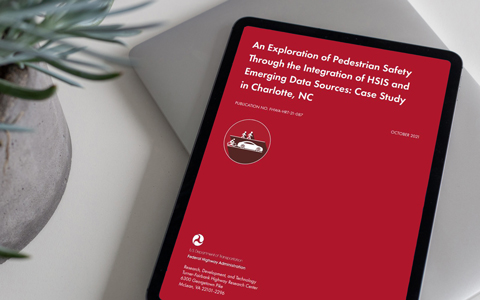
As pedestrian safety concerns continue to rise for the transportation industry across the country, agencies are eager to find best practices and innovative approaches to improve the streetscape for all users. The Federal Highway Administration (FHWA) and VHB built upon their strong research partnership and the Highway Safety Information System (HSIS) to conduct a safety study using emerging and state-of-the-practice data sources to identify factors that influence pedestrian crash severity and probability. This investigation revealed several factors that influence pedestrian safety, quantifying their impacts and providing evidence to support future road safety management.
The study, An Exploration of Pedestrian Safety Through the Integration of HSIS and Emerging Data Sources: Case Study in Charlotte, NC, explored several high-priority research topics in safety data and analysis, including pedestrian exposure analysis; data from devices carried by vehicles or travelers, known as probe data; and geospatial HSIS data. In addition, key topics on pedestrian safety were studied, including the “safety in numbers” effect and the influence of speed in pedestrian risk.
“There are several factors that influence the severity of a pedestrian crash,” said Ian Hamilton, Transportation Planner at VHB. “Vehicle speed is a leading contributing factor, but the age of the pedestrian, crossing distance, and traffic volumes impact the situation as well. By incorporating emerging data sources, we were able to analyze these factors as part of the study as well.”
With advancements in data availability, integration, and analysis methodologies, the objective of the study analyzed two measures of pedestrian safety performance in Charlotte, NC. These measures included studying the severity of pedestrian crashes that occurred and evaluating existing roadway segments to determine how likely a pedestrian crash would be. To accomplish the study objectives, the research team leveraged data from several agencies and sources to supplement more roadway or contextual transportation data. The research team also developed a pedestrian count model to predict pedestrian volumes at locations without pedestrian counts.
“One of the challenges for measuring pedestrian and bicycle safety and risk is information on exposure—the risk to the individual user,” said Ian. “Agencies struggle to obtain the resources to collect these volumes, and traditionally it can be expensive. Our innovative approach to creating a pedestrian count model allowed us to evaluate the impacts of infrastructure characteristics, traffic volumes, and vehicular speed on pedestrian safety over an entire network without a resource intensive count program.”
The results from the study concluded that pedestrian exposure at a given intersection was found to be significantly influenced by demographic and socioeconomic characteristics, employment, land use, sidewalk presence, transit access, and roadway and intersection characteristics. It identified numerous factors that influence pedestrian crash severity and probability, including vehicle speeds, traffic volumes, intersection proximity, and other crash-related factors. Furthermore, the researchers noted statistical evidence supporting the “Safety in Numbers” effect, as well as an application for using speed data in pedestrian safety analysis. To the author’s knowledge, there have not been any significant prior research efforts that have used this approach for pedestrian safety.
These results can be used to identify locations that are more susceptible to pedestrian safety risks to support future design and infrastructure that align with the FHWA’s Safe System approach to reduce the number of fatalities and serious injuries of all road users by proactively putting safeguards in place.
Join VHB at the Transportation Research Board (TRB) Annual Meeting on January 10th from 8:00 a.m. – 9:30 a.m. to learn more about this topic and meet the authors of the case study: Ian Hamilton, Kristin Kersavage, Richard Porter, and Keith Smith.
Not planning to attend TRB? Read the full case study or contact Ian Hamilton.
